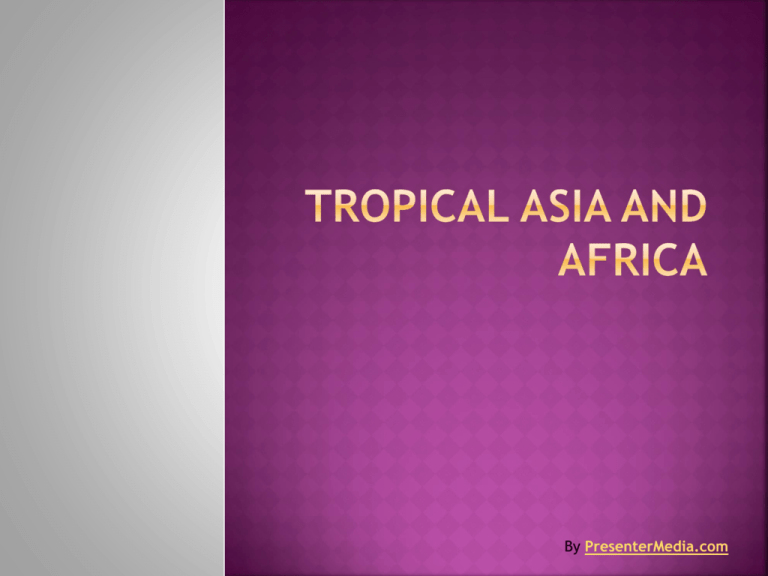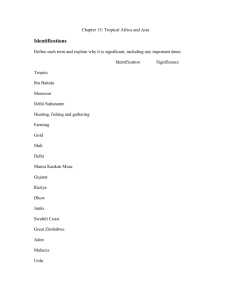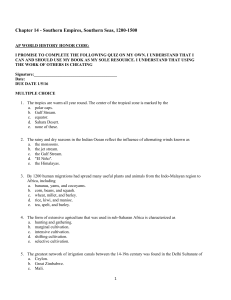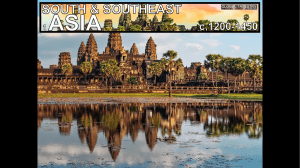Tropical Asia and Africa - iMater Charter Middle/High School
advertisement

By PresenterMedia.com • • • • Afro-Asian tropics have a cycle of rainy and dry seasons dictated by winds known as monsoons. Tropical Zones have areas of abundant rainfall as well as arid zones. Tropics has an uneven distribution of rainfall during the year. In order to have year-round access to water, tropical farming societies constructed: Dams (India) Irrigation canals (Vietnam, Java, Malaysia) Reservoirs o o o Tropical peoples used iron for agricultural implements, weapons, and needles. Copper was used to make wire and decorative objects. Africa produced a great deal of gold. • Islam spread to sub-Saharan Africa by a gradual process of peaceful conversion. (commercial contracts) • Kingdom of Mali: Economy rested on agriculture Supplemented by control of: regional and trans-Saharan trading routes Gold mines of the Niger headwaters Mansa Kankan Musa 1312-1337 -Demonstrated his wealth during a pilgrimage to Mecca. (too rich to quit) -Upon his return to Mali, he established new Mosques and Quranic schools. (Timbuktu) - Decline caused by rebellion from within and attacks from the outside o India Between 1206 and 1236 Northwest India was defeated by violent Muslim Turkish conquerors. (pillage and plunder) Led by Sultan Iltutmish Established Delhi Sultanate as a Muslim state Things eventually settle down but, Hindus remain resentful Had a female ruler at one point. o o o In general, they ruled by terror and were a burden on their subjects. In the mid-fourteenth century, internal rivalries and external threats undermined the stability of the Sultanate. Sultanate was destroyed when Timur sacked Delhi in 1398. • Decentralized and cooperative • In each region a certain port functioned as the major emporium for trade in which good from smaller ports were consolidated and shipped onward. • Indian Ocean trade increased between 1200 and 1500 Stimulated by the: prosperity of Latin Europe, Asian, and African states Collapse of overland trade routes • In the Red and Arabian Seas, trade was carried on dhows. • From India on to Southeast Asia, junks dominated the trade routes. Junk Technologically advanced vessels (China and later Bengal) Had watertight compartments Up to 12 sails Carried up to 1,000 tons • • • • Junk Dhow • By 1500, separate city-states along the E. Africa coast participated in Indian Ocean trade. • The people of these coastal cities, the “Swahili” people • • Language that combined native African with Arabic and Persian Major export was in gold mined in southern portion of Africa. Swahili • • • Great Zimbabwe’s economy rested on agriculture, cattle herding, and most importantly longdistance trade. Traded: copper, salt, manufactures, and gold. City declined due to an ecological crisis brought on by deforestation and overgrazing. Zimbabwe • • • • Enough rainfall to produce wheat for export. Location that made it a central transit point for trade in the Middle East. Common interest in trade allowed peoples to live in peace. Exchange zone for cotton and beads (India), spices (SE Asia), horses (Arabia), pearls (red sea), slaves, gold and ivory (Ethiopia) Aden • • • • • Grew with the growth of Arabian sea trade and rise of the Delhi Sultanate Exported cotton textiles and indigo in return for gold and silver. Gujarat manufactured textiles, leather goods, carpets, silk, and other commodities. Gujarat’s overseas trade was dominated by Muslims, but Hindus also benefited. Spread Islam among E. Indian traders Gujarat • • • Calicut and other cities of the Malabar Coast exported cotton textiles and spices. Also served as clearinghouses for long-distance trade. Cities of the Malabar Coast were unified in a loose confederation whose rulers were tolerant of other religious and ethnic groups. Malabar Coast • • • • • Strait of Malacca is the principal passage from the Indian Ocean to the South China Sea. In the fourteenth century a gang of Chinese pirates preyed upon the strait In 1407, the forces of the Ming dynasty crushed the Chinese pirates. Muslim ruler of Malacca took advantage of this to exert his domination over the strait. Had rubies and musk (Burma), gold (Sumatra), cloves and nutmeg (Moluccas) Malacca o o o o o Architecture: local cultures incorporated and changed ideas, customs, and architectural styles from other civilizations. Education: Spread of Islam brought literacy to African peoples who learned Arabic. Then they used Arabic script to write their own languages In the case of India spread of Islam inspired a new language Urdu. As Islam spread to Africa, India, and Southeast Asia, Islam also brought: Study of Islamic law and administration Greek science, mathematics, and medicine Timbuktu, Delhi, and Malacca were new centers of Islamic learning. Muslim domination of trade contributed to the spread of Islam as merchants converted and traveled. Islamic destruction of the last center of Buddhism in India contributed to the spread of Islam in India. Islam changed as it spread to different societies.(i.e. attitudes towards women) It also brought major changes to society as well. (India) More wealth in trade states= bigger gap between rich and poor. Slavery increased in both Africa and in India. Approx. 2.5 million slave from Africa (cheap!) Most male slaves were trained in specific skills (oxymoron: some became rich and powerful) Women worked as entertainers and in the household Women throughout this period still remained subservient + status determined by male master + cook, brew, spin thread, and work on farms + Islam seemed to have a varied effect on women









